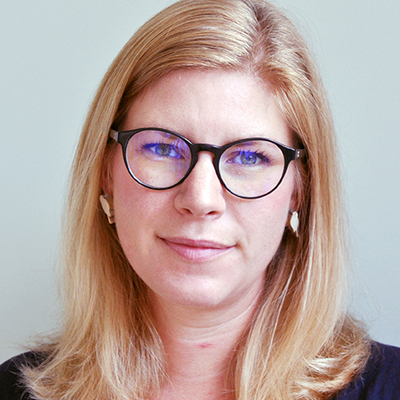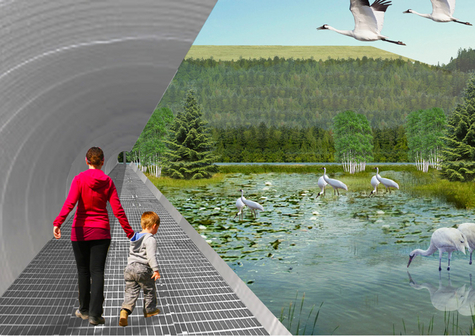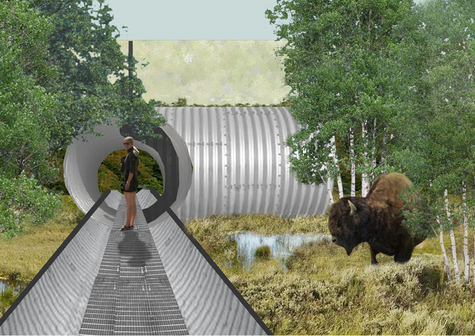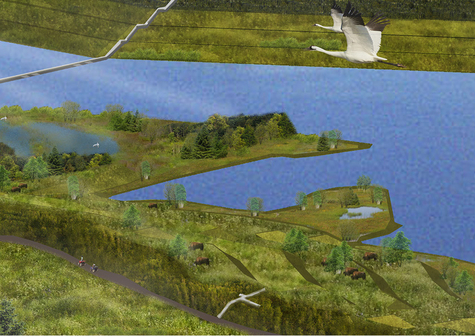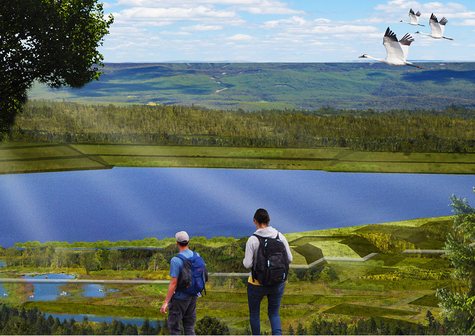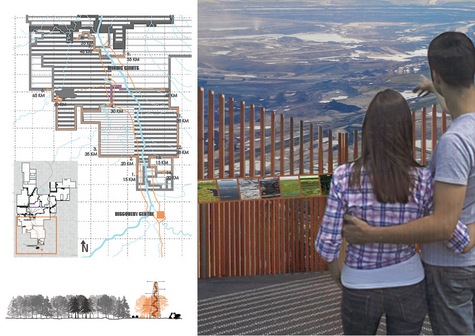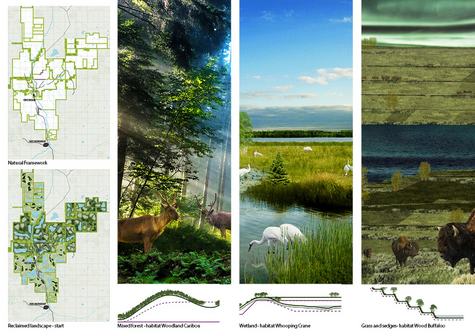Esther Brun
- Opleiding
- Landschapsarchitectuur
- Lichting
- 2016
MIN(e)Dscape: The Transformation of Canada’s Future Industrial Heritage
MIN(e)Dscape offers a strategy for the reclamation of the oil sand mining landscape in the north of Alberta, Canada.
The main objective of the strategy is the preservation of Canada’s future industrial heritage by means of transformation of the landscape into nature with significant ecological value and diversity. The strategy proves the expediency of the mining landscape as a proficient base for nature development. MIN(e)Dscape is founded on two pillars, Culture and Nature, merged together in an overall framework. The cultural frame is focused on education, information and the experience of the mining landscape. The current image of the oil sands is extremely negative due to the impact of the industry on nature, the climate and the landscape. This negative image is mainly based on the campaigns of environmental organisations and is not based on personal experience. My assumption is that by increasing the accessibility and knowledge of the landscape the greater public will attain a different connection with the landscape. As a old Dutch saying goes: ‘unknown, unloved’.
The Cultural Frame consists of three elements: the (already existing) Oil Sand Discovery Centre in Fort.McMurray, de ‘Drilling Tower’ look-outs and the ‘Timeless Quarry’ museum park with educational route ‘Timeline’. At the discovery centre, the public will learn all about the theoretical side of the oil sand mining process, the emergence and discovery of the material and of course existing reclamation methods. The ‘Drilling Towers’ are introduced to let visitors become acquainted with the landscape. It is a network of 13 look-outs, strategically placed within the area. From each lookout, a different stage of the mining landscape can be witnessed. This gives you the opportunity to observe the theory becoming reality and observe the transformation of the landscape. ‘Timeless Quarry’ museum park offers a view into the future. The park is situated in an old open pit mine and showcases all the possible reclamation landscapes from the start up to the state after natural transformation. The park also provides the opportunity to experience the extreme scale and size of the mining landscape from a human perspective. In summary, the cultural framework will introduce the public to all aspects of the oil sand industry and show the magnificence of the mining landscape and the opportunities it provides for the future.
The Natural Frame focuses on the future by preserving parts of the existing boreal landscape in the present day. By maintaining a zone of old growth boreal forest, a life seed bank will be secured for the pollination of adjacent reclamation sites in the future. The Natural Frame also incorporates a ecological corridor that can be used by the highly endangered Woodland Caribou amongst others. The completion of the frame is focused on the transformation of the former mining landscape into nature, specifically designed for three target species which are: the woodland caribou, the wood buffalo and the whooping crane. All of these animals are endangered or affected by the oil sand industry. This results in also three different landscape typologies native to the area; mixed forest, open plains of grasses and sedges and wetlands. These nature typologies will be set on the mining topography. In this way, each characteristic element of the mining landscape will transform into its own new natural landscape. The open pit is provides an eloquent base for the open grassfields, the overburden hills will transform into mixed forests and the tailing ponds offer a sufficient topographical base for the transformation into secluded wetlands. The remaining infrastructure and building sites will be allocated to either open plains or mixed forest, according to their location within thee total area.
In this way the MIN(e)Dscape strategy and design presents an alternative to traditional reclamation methods that erase the typical mining landscape and thereby the future industrial heritage of Canada. Implementing the MIN(e)Dscape strategy will involve people with the industry and the landscape in particular; slowly conquering a place in society and culture, and hopefully also their hearts.
Commission members: Gloria Font (mentor), Mirjam Koevoet, Rik de Visser. Additional members for the examination: Rob de Leeuw, Berdie Olthof.
